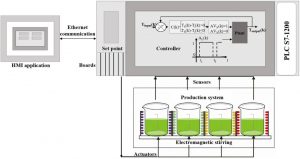Microalgae are becoming increasingly important as biofeed stocks for a wide range of products from food to cosmetics, to specialty chemicals and biofuels.
A study by John Cortez-Romero and co-workers uses a closed photobioreactor system, along with precise extraction and analysis methods, to elegantly demonstrate that specific lipid production in microalgae can be directed by controlling the wavelength and density of the irradiating light.

System components: programmable logic controller, boards, sensors and actuators, human-machine interface and productionsystem.
To study the interrelation between wavelength and intensity on algal growth and lipid production, microalgae was cultivated under red (λ=620-750 nm), yellow (λ=570-590 nm), green (λ=495-570 nm), and violet (λ=380-450 nm) light. Additionally, varying light intensities was applied to each culture (I1=8.75, I2=14.22 and I3=19.69 W·m-2), with results showing biomass production was directly proportionate to the intensity level.
Acutodesmus obliquus microalgae biomass production directly corresponds to irradiance; biomass production is higher when cultures are illuminated by violet, yellow, or red light, with the highest lipid production occurring with red light at 19.69 W.m-2.
The study demonstrates that palmitic, linoleic, and linolenic were the most produced lipids, showing a clear dependence between light wavelength and irradiance for biomass and lipid production.
The findings have the potential of positively impacting the industrial production of algae-derived lipids for a variety of applications (i.e. energy, cosmetics, applications in the pharmacological and food industries) by allowing the control of the type of lipids being produced by simply choosing the wavelength and density of light used in the microalgae culture.

















